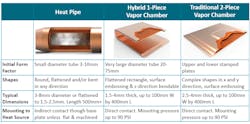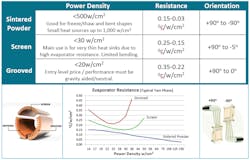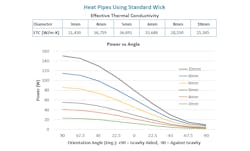This article is part of the TechXchange: Cool Designs.
I bet everyone reading this article knows that heat pipes and vapor chambers are two-phase devices used as part of a thermal solution. But, do you know how they’re different, when they should be used, or why they’re so effective?
In this article, I limit the text and maximize the illustrations and tables to quickly get you up to speed on these amazing little devices (Table 1 below). I’ll also provide some links to thermal calculators you’ll find useful. If you’re unfamiliar with the inner working of two-phase devices, please refer to this page.
Table 1: Both heat pipes and one-piece vapor chambers start the manufacturing process as a copper tube offering cost and shaping benefits. Two-piece vapor chambers begin life as two stamped plates.
When Should I Use These Devices?
There’s no hard and fast rule here. But generally, you’ll use heat pipes to move heat and vapor chambers to spread it (Fig. 1). Heat pipes can be easily bent and flattened to wrap around crowded system components, making them the go-to choice when heat needs to be moved from the heat source to a remote fin stack—usually for distances greater than 40 to 50 mm.
1. Vapor chambers are most often used to spread heat to a local heat sink, whereas heat pipes are generally better for moving heat to a remote sink.
Vapor chambers have a very large continuous area, allowing for better isothermalization of the heat sink. If you need a heat sink that’s minimally 10 times, but usually closer to 20 times, the area of the heat source, consider vapor chambers. At the beginning of the design cycle, you can use a heat sink sizing calculator to estimate the required volume of the heat sink.
These Devices Can Be “Tuned” for Specific Applications
2. While heat pipes that use grooved or mesh wicks save cost and allow for smaller diameters, their performance characteristics fall far short of those using sintered wicks.
Three types of wick structures are found in heat pipes and vapor chambers. A copper sintered wick is by far the most prevalent due to its higher power-handling capacity, low thermal resistance, and ability to work against gravity. What isn’t so widely known is the tremendous amount of tuning that can happen within these devices (Fig. 2).
Changes to wick thickness, wick porosity, and fluid charge may dramatically alter the performance characteristics of the device. That’s why engineers should use published performance data as a general guideline and not the final word. Here’s an example from Celsia's online heat pipe performance calculator that shows Thermal Conductivity and Qmax versus Angle for heat pipes using a standard wick (Fig. 3).
3. Results from Celsia’s online heat pipe performance calculator show the power-handing capacities for various diameter heat pipes.
For heat pipes with the room for a thicker wick (4 to 10 mm), the maximum power-handling capacity increases by 17.5% to 45% when compared to a standard wick. Among the tradeoffs are slightly reduced effective thermal conductivity and shaping flexibility. Standard wick heat pipes are able to be flattened more than performance wick heat pipes before it negatively affects performance (Table 2).
Table 2: Choosing a performance wick structure increases power handling, but heat-pipe flattening can’t be as dramatic because it begins to negatively affect performance.
Vapor Chambers Can Dramatically Reduce Spreading Resistance
Heat sources with high power densities or limited air flow to the heat sink to cool them often require a heat sink base material. Such material is more thermally conductive than either solid aluminum or copper. This is where vapor chambers come in handy. Figure 4 presents a summary of the results generated from Celsia's spreading delta-T calculator.
4. Celsia’s online spreading delta-T calculator helps engineers quickly see if vapor chambers can substantially reduce spreading resistance in the base of the heat sink.
As a rule of thumb, engineers should consider a vapor chamber when the spreading delta-T in the base is larger than 10oC. This equals roughly 25% to 33% of a typical thermal budget. As seen in the previous example, both copper and aluminum bases far exceed this rule. Changing to a vapor chamber reduces the delta-T to a manageable 5oC.
In summary, heat pipes and vapor chambers are incredibly versatile devices for those times when heat must be moved to a remote condenser or spread to a local one. They’re dependable, relatively inexpensive, and they provide considerable design flexibility.







